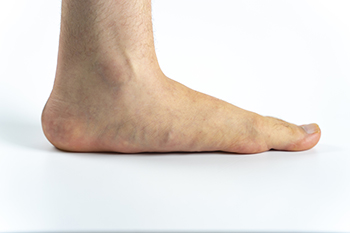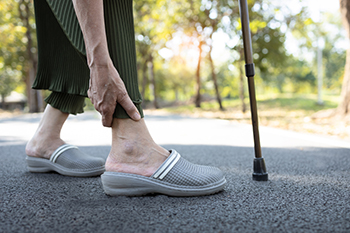February 2023
Do Flat Feet Hurt?

Flat feet can have various effects on people. Some patients will experience discomfort during everyday activities, and others wont have any pain. People who have flat feet have a low arch or none at all. Most babies are born with flat feet, and the arch generally develops during the teenage years. Flat feet fall into two categories. Patients with flexible flat feet will maintain an arch, but it disappears when the foot lies flat on the ground. With rigid flat feet, the arch is completely gone, with or without weight being exerted on the foot. Adults may be prone to developing flat feet if they have foot muscle weakness or ankle instability. There are stretches that can be performed to help reduce the achy sensation that sometimes accompanies flat feet. One example is standing on a step and lowering one heel at a time until a gentle stretch is felt. If you have flat feet, a podiatrist can provide you with additional stretches that can help to strengthen the foot and possibly diminish existing pain.
Flatfoot is a condition many people suffer from. If you have flat feet, contact Dr. Lee R. Stein from Lake Shore Foot & Ankle, PC. Our doctor will treat your foot and ankle needs.
What Are Flat Feet?
Flatfoot is a condition in which the arch of the foot is depressed and the sole of the foot is almost completely in contact with the ground. About 20-30% of the population generally has flat feet because their arches never formed during growth.
Conditions & Problems:
Having flat feet makes it difficult to run or walk because of the stress placed on the ankles.
Alignment – The general alignment of your legs can be disrupted, because the ankles move inward which can cause major discomfort.
Knees – If you have complications with your knees, flat feet can be a contributor to arthritis in that area.
Symptoms
- Pain around the heel or arch area
- Trouble standing on the tip toe
- Swelling around the inside of the ankle
- Flat look to one or both feet
- Having your shoes feel uneven when worn
Treatment
If you are experiencing pain and stress on the foot you may weaken the posterior tibial tendon, which runs around the inside of the ankle.
If you have any questions please feel free to contact one of our offices located in Chicago, Highland Park, and Uptown, IL . We offer the newest diagnostic and treatment technologies for all your foot and ankle needs.
What Is Cuboid Syndrome?

Cuboid syndrome causes lateral, or side, midfoot pain. It is thought to be a result of injury to the calcaneocuboid joint because of a recurrent or forceful impact on the cuboid bone. The cuboid is a small midfoot bone that connects the outer metatarsals to the heel bone. A person with cuboid syndrome usually has swelling, lateral foot pain, and an unnatural gait. This can happen from running over a protrusion in the ground, such as a tree root, spraining one’s ankle that does not respond to treatment, or from peroneal tendinopathy, which is overuse of the peroneal tendons. Diagnosis is often made by taking a history of the patient, asking about any injuries incurred, and examining the foot. If you are suffering from lateral midfoot pain, it is a good idea to see a podiatrist for a proper diagnosis and treatment.
Cuboid syndrome, also known as cuboid subluxation, occurs when the joints and ligaments near the cuboid bone in the foot become torn. If you have cuboid syndrome, consult with Dr. Lee R. Stein from Lake Shore Foot & Ankle, PC. Our doctor will assess your condition and provide you with quality foot and ankle treatment.
Cuboid syndrome is a common cause of lateral foot pain, which is pain on the outside of the foot. The condition may happen suddenly due to an ankle sprain, or it may develop slowly overtime from repetitive tension through the bone and surrounding structures.
Causes
The most common causes of cuboid syndrome include:
- Injury – The most common cause of this ailment is an ankle sprain.
- Repetitive Strain – Tension placed through the peroneus longus muscle from repetitive activities such as jumping and running may cause excessive traction on the bone causing it to sublux.
- Altered Foot Biomechanics – Most people suffering from cuboid subluxation have flat feet.
Symptoms
A common symptom of cuboid syndrome is pain along the outside of the foot which can be felt in the ankle and toes. This pain may create walking difficulties and may cause those with the condition to walk with a limp.
Diagnosis
Diagnosis of cuboid syndrome is often difficult, and it is often misdiagnosed. X-rays, MRIs and CT scans often fail to properly show the cuboid subluxation. Although there isn’t a specific test used to diagnose cuboid syndrome, your podiatrist will usually check if pain is felt while pressing firmly on the cuboid bone of your foot.
Treatment
Just as the range of causes varies widely, so do treatments. Some more common treatments are ice therapy, rest, exercise, taping, and orthotics.
If you have any questions, please feel free to contact one of our offices located in Chicago, Highland Park, and Uptown, IL . We offer the newest diagnostic and treatment technologies for all your foot care needs.
Blisters and Vaseline

If you are someone who wears shoes that rub up against your skin or shoes that are simply too tight, you may be putting yourself at an increased risk of developing blisters. Blisters on the feet are certainly nothing to take too lightly. These blisters may develop on the feet in different areas such as the heels and toes. If you have a blister that falls off prematurely, leaving a wound exposed, a podiatrist can help you address this problem. Depending on the nature of the blister and your particular case, a podiatrist may suggest a variety of different things. For example, a podiatrist may recommend that you would benefit most from applying petroleum jelly to the wound and covering it with a bandage. The goal of taking these steps is to facilitate the healing of the underlying wound. Please contact a podiatrist today for more information and correct treatment options.
Blisters are prone to making everyday activities extremely uncomfortable. If your feet are hurting, contact Dr. Lee R. Stein of Lake Shore Foot & Ankle, PC. Our doctor can provide the care you need to keep you pain-free and on your feet.
Foot Blisters
Foot blisters develop as a result of constantly wearing tight or ill-fitting footwear. This happens due to the constant rubbing from the shoe, which can often lead to pain.
What Are Foot Blisters?
A foot blister is a small fluid-filled pocket that forms on the upper-most layer of the skin. Blisters are filled with clear fluid and can lead to blood drainage or pus if the area becomes infected.
How Do Blisters Form?
Blisters on the feet are often the result of constant friction of skin and material, usually by shoe rubbing. Walking in sandals, boots, or shoes that don’t fit properly for long periods of time can result in a blister. Having consistent foot moisture and humidity can easily lead to blister formation.
Prevention & Treatment
It is important to properly care for the affected area in order to prevent infection and ease the pain. Do not lance the blister and use a Band-Aid to provide pain relief. Also, be sure to keep your feet dry and wear proper fitting shoes. If you see blood or pus in a blister, seek assistance from a podiatrist.
If you have any questions, please feel free to contact one of our offices located in Chicago, Highland Park, and Uptown, IL . We offer the newest diagnostic and treatment technologies for all your foot care needs.
Senior Citizens and Athlete’s Foot

Athlete’s foot is a fairly well-known condition that reduces the health of the feet. It is spread in warm, moist environments, and is ultimately caused by a fungal infection. If you are a senior citizen or are caring for one, it is important to know that seniors might be more susceptible to athlete’s foot than the general public. There are several reasons for this. Most importantly, athlete’s foot can thrive in shoes and feet when they are not regularly cleaned and dried. Sometimes, certain senior citizens lack the mobility and flexibility to regularly clean and dry their own feet. As a result, the senior becomes even more susceptible to developing athlete’s foot. If you are a senior struggling with athlete’s foot, schedule an appointment with a podiatrist today.
Proper foot care is something many older adults forget to consider. If you have any concerns about your feet and ankles, contact Dr. Lee R. Stein from Lake Shore Foot & Ankle, PC. Our doctor can provide the care you need to keep you pain-free and on your feet.
The Elderly and Their Feet
As we age we start to notice many changes in our body, but the elder population may not notice them right away. Medical conditions may prevent the elderly to take notice of their foot health right away. Poor vision is a lead contributor to not taking action for the elderly.
Common Conditions
- Neuropathy – can reduce feeling in the feet and can hide many life-threatening medical conditions.
- Reduced flexibility – prevents the ability of proper toenail trimming, and foot cleaning. If left untreated, it may lead to further medical issues.
- Foot sores – amongst the older population can be serious before they are discovered. Some of the problematic conditions they may face are:
- Gouging toenails affecting nearby toe
- Shoes that don’t fit properly
- Pressure sores
- Loss of circulation in legs & feet
- Edema & swelling of feet and ankles
Susceptible Infections
Diabetes and poor circulation can cause general loss of sensitivity over the years, turning a simple cut into a serious issue.
If you have any questions please feel free to contact one of our offices located in Chicago, Highland Park, and Uptown, IL . We offer the newest diagnostic and treatment technologies for all your foot and ankle needs.
Are Bunions Affecting Your Everyday Life?
Blog Archives
- April 2025
- March 2025
- February 2025
- January 2025
- December 2024
- November 2024
- October 2024
- September 2024
- August 2024
- July 2024
- June 2024
- May 2024
- April 2024
- March 2024
- February 2024
- January 2024
- December 2023
- November 2023
- October 2023
- September 2023
- August 2023
- July 2023
- June 2023
- May 2023
- April 2023
- March 2023
- February 2023
- January 2023
- December 2022
- November 2022
- October 2022
- September 2022
- August 2022
- July 2022
- June 2022
- May 2022
- April 2022
- March 2022
- February 2022
- January 2022
- December 2021
- November 2021
- October 2021
- September 2021
- August 2021
- July 2021
- June 2021
- May 2021
- April 2021
- March 2021
- February 2021
- January 2021
- December 2020
- November 2020
- October 2020
- September 2020
- August 2020
- July 2020
- June 2020
- May 2020
- April 2020
- March 2020
- February 2020
- January 2020
- December 2019
- November 2019
- October 2019
- September 2019
- August 2019
- July 2019
- June 2019
- May 2019
- April 2019
- March 2019
- February 2019
- January 2019
- December 2018
- November 2018
- October 2018
- September 2018
- August 2018
- July 2018








